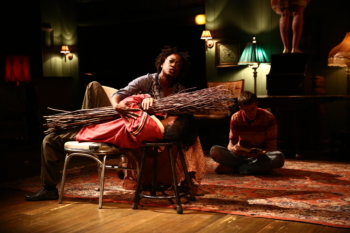
The Sound and the Fury • Press
- The New York Times May 21, 2015
- TimeOut New York January 20, 2015
- Entertainment Weekly May 21, 2015
- Theatermania May 21, 2015
- Exeunt Magazine May 21, 2015
- New York Post May 21, 2015
- New York Daily News May 22, 2015
- Huffington Post May 21, 2015
- The Bergen Record May 22, 2015
- The Advertiser March 12, 2010
- The Australian March 15, 2010
- Expresso-Actual January 24, 2009
- Publico January 20, 2009
- The New Yorker May 26, 2008
- The New Yorker May 5, 2008
- The New York Times April 30, 2008
- Time Out New York April 30-May 6, 2008
- Time Out New York April 30, 2008
- The New York Sun April 30, 2008
- The International Herald Tribune April 29, 2008
- Backstage April 29, 2008
- Variety April 29, 2008
- The New York Times April 27, 2008
- Variety November 30, 2007
- The Brooklyn Rail April 2008
- The Village Voice March 4, 2008
- Variety November 30, 2007
The Sound and the Fury
By Samuel L. Leiter
There are presently two Off Broadway companies that specialize in adapting novels to the stage, Godlight Theatre Company and Elevator Repair Service (ERS). The former, whose Cool Hand Luke, directed by Joe Tantalo, is currently running at 59E59 Theaters, creates pared-down dramatizations, using relatively small casts with minimal means, while the latter, with bigger casts and larger budgets, actually performs the original work, including narrative descriptions and “he saids” and “she saids.” Their latest offering, William Faulkner’s The Sound and the Fury, directed by John Collins, is a revival of a work they first staged in 2008. It’s a brilliant, sometimes mesmerizing production but—ticket buyer beware—if you don’t know the book, or don’t remember your English professor’s lectures about it, you’re going to find it something of a slog.
Unlike ERS’s most famous production, the seven-hour Gatz (2009), which presented the full text of Fitzgerald’s The Great Gatsby, The Sound and the Fury runs a bit over a relatively miniscule two hours and fifteen minutes, albeit without an intermission; that’s because only the first of its four parts, “August 7, 1928” (the Benjy chapter), is presented. In contrast to Fitzgerald’s linear storytelling, Faulkner’s 1929 novel, much of it using a Joycean stream of consciousness, is famously opaque, and ERS makes things even more dense by having some roles played by more than one actor (sometimes simultaneously), some with blacks as whites and vice versa, with actors crossing the gender divide or playing children.
The Sound and the Fury takes its title from a line in Macbeth, a choice inspired by Benjy (mainly Susie Sokol, but also Aaron Landsman), the moaning, slobbering idiot (Faulkner’s word) at the heart of the story, which describes the decline of the decadent Compson family, once dignified and genteel but gone to seed and living on the remains of their plantation in Jefferson, Mississippi. Despite Benjy’s impairment, it’s through his disconnected memories at age thirty-three that we view the action, which shifts without warning back and forth in time between 1928 and 1898, as one or the others of the family engage in lust, castration, robbery, incest, and suicide.
Excerpt from “The Sound and the Fury” review by Samuel L. Leiter. Read the full article here.